A Comprehensive Report on Personality Traits and Social Media Use
VerifiedAdded on 2023/06/09
|27
|6715
|221
Report
AI Summary
This research report investigates the association between personality traits (conscientiousness, neuroticism, need for companionship, and exhibitionism) and social media usage. The study uses a quantitative research approach with data collected from 116 participants and analyzed using SPSS. The results indicate a moderate correlation between predictor variables and social media usage, with personality traits accounting for a significant portion of the variance in social media use. Hypothesis testing confirms a statistically significant relationship between social media usage and the specified personality traits. The report also includes a literature review discussing the impact of social media on well-being and the role of personality in online behavior.
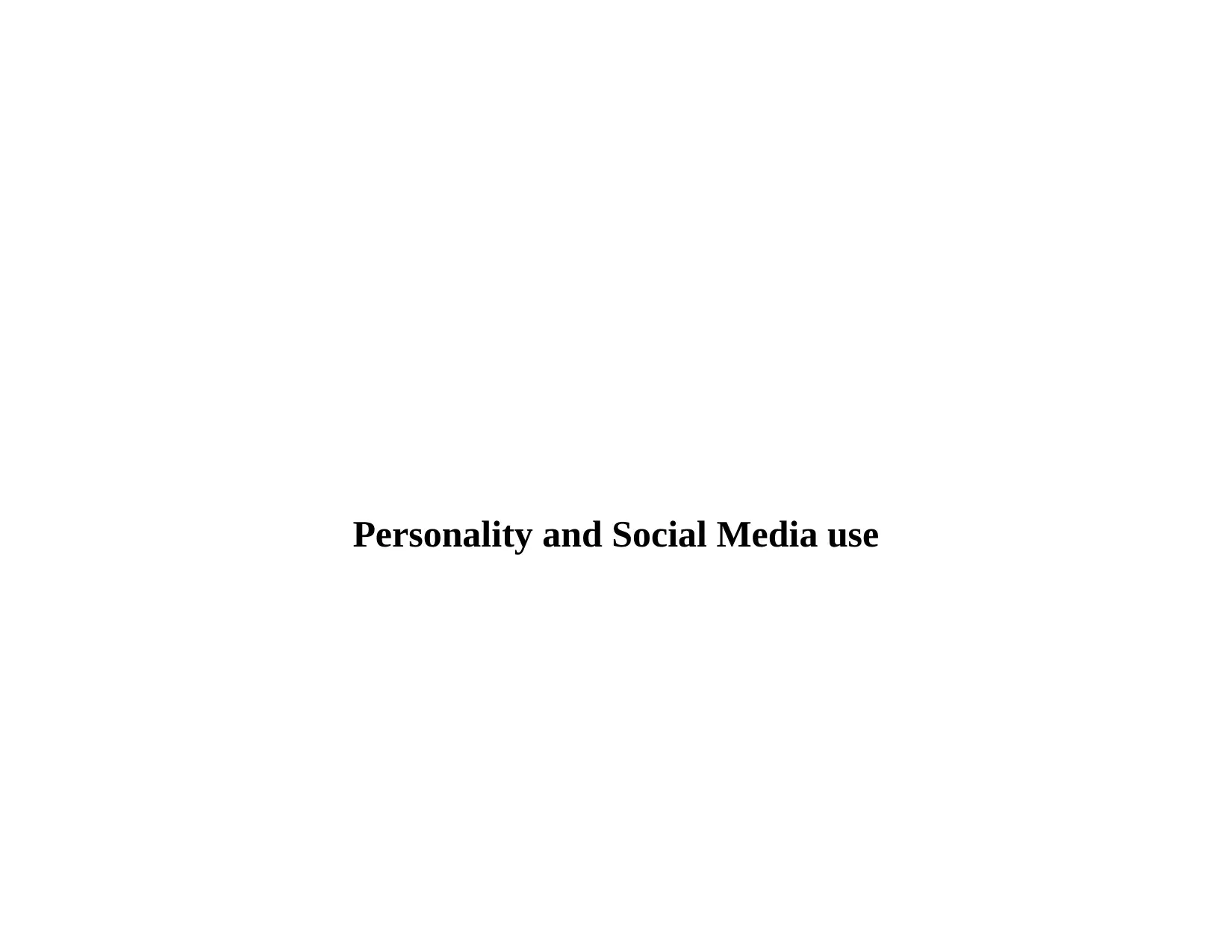
Personality and Social Media use
Paraphrase This Document
Need a fresh take? Get an instant paraphrase of this document with our AI Paraphraser

Table of Contents
ABSTRACT................................................................................................................................................................................................3
INTRODUCTION.......................................................................................................................................................................................4
Background..............................................................................................................................................................................................4
METHODS..................................................................................................................................................................................................8
Research type...........................................................................................................................................................................................8
Data collection methods..........................................................................................................................................................................8
Data analysis............................................................................................................................................................................................8
Participants..............................................................................................................................................................................................9
Materials..................................................................................................................................................................................................9
RESULTS....................................................................................................................................................................................................9
Descriptive statistics................................................................................................................................................................................9
Inferential statistics................................................................................................................................................................................11
Parametric test.......................................................................................................................................................................................11
Non-parametric test...............................................................................................................................................................................13
DISCUSSION............................................................................................................................................................................................17
REFERENCES..........................................................................................................................................................................................23
ABSTRACT................................................................................................................................................................................................3
INTRODUCTION.......................................................................................................................................................................................4
Background..............................................................................................................................................................................................4
METHODS..................................................................................................................................................................................................8
Research type...........................................................................................................................................................................................8
Data collection methods..........................................................................................................................................................................8
Data analysis............................................................................................................................................................................................8
Participants..............................................................................................................................................................................................9
Materials..................................................................................................................................................................................................9
RESULTS....................................................................................................................................................................................................9
Descriptive statistics................................................................................................................................................................................9
Inferential statistics................................................................................................................................................................................11
Parametric test.......................................................................................................................................................................................11
Non-parametric test...............................................................................................................................................................................13
DISCUSSION............................................................................................................................................................................................17
REFERENCES..........................................................................................................................................................................................23
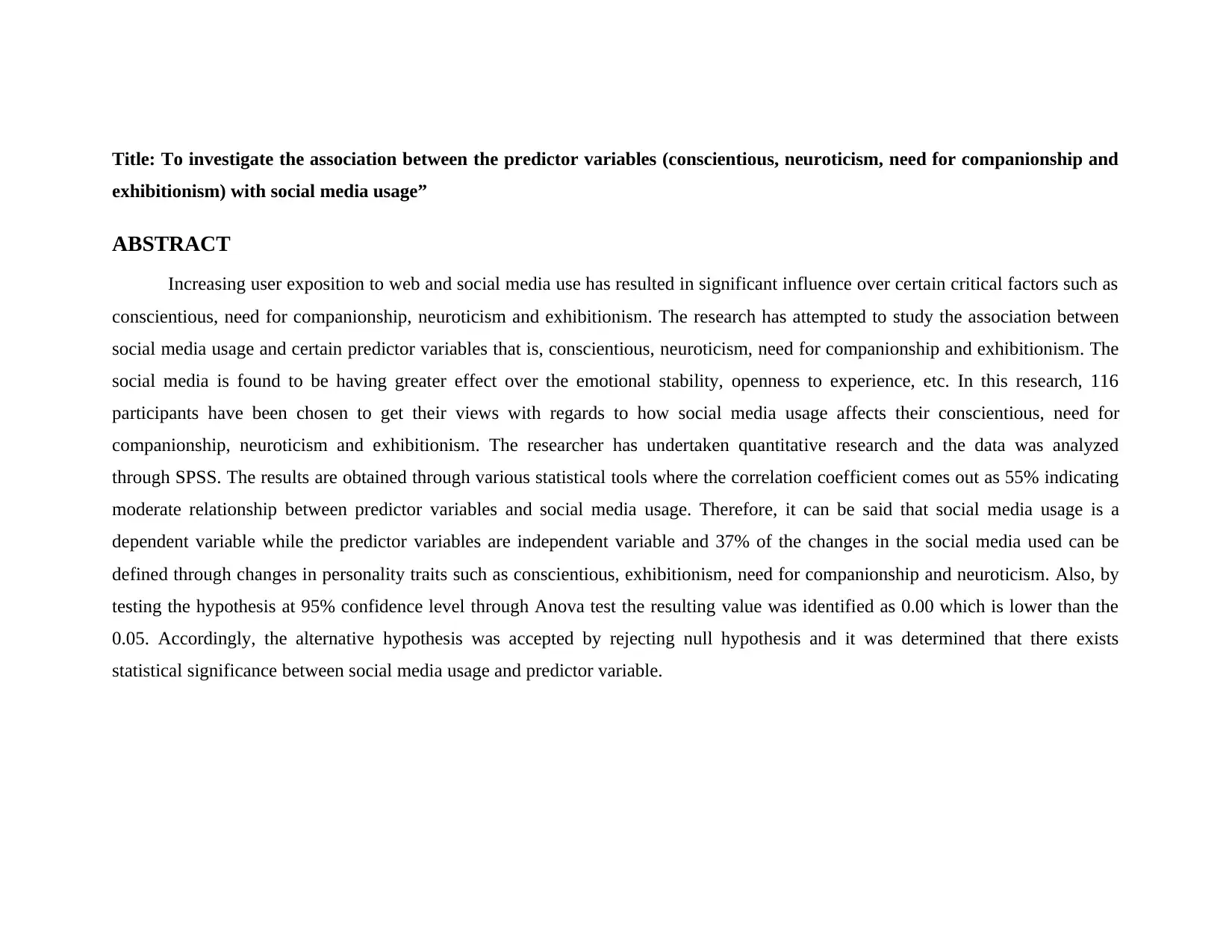
Title: To investigate the association between the predictor variables (conscientious, neuroticism, need for companionship and
exhibitionism) with social media usage”
ABSTRACT
Increasing user exposition to web and social media use has resulted in significant influence over certain critical factors such as
conscientious, need for companionship, neuroticism and exhibitionism. The research has attempted to study the association between
social media usage and certain predictor variables that is, conscientious, neuroticism, need for companionship and exhibitionism. The
social media is found to be having greater effect over the emotional stability, openness to experience, etc. In this research, 116
participants have been chosen to get their views with regards to how social media usage affects their conscientious, need for
companionship, neuroticism and exhibitionism. The researcher has undertaken quantitative research and the data was analyzed
through SPSS. The results are obtained through various statistical tools where the correlation coefficient comes out as 55% indicating
moderate relationship between predictor variables and social media usage. Therefore, it can be said that social media usage is a
dependent variable while the predictor variables are independent variable and 37% of the changes in the social media used can be
defined through changes in personality traits such as conscientious, exhibitionism, need for companionship and neuroticism. Also, by
testing the hypothesis at 95% confidence level through Anova test the resulting value was identified as 0.00 which is lower than the
0.05. Accordingly, the alternative hypothesis was accepted by rejecting null hypothesis and it was determined that there exists
statistical significance between social media usage and predictor variable.
exhibitionism) with social media usage”
ABSTRACT
Increasing user exposition to web and social media use has resulted in significant influence over certain critical factors such as
conscientious, need for companionship, neuroticism and exhibitionism. The research has attempted to study the association between
social media usage and certain predictor variables that is, conscientious, neuroticism, need for companionship and exhibitionism. The
social media is found to be having greater effect over the emotional stability, openness to experience, etc. In this research, 116
participants have been chosen to get their views with regards to how social media usage affects their conscientious, need for
companionship, neuroticism and exhibitionism. The researcher has undertaken quantitative research and the data was analyzed
through SPSS. The results are obtained through various statistical tools where the correlation coefficient comes out as 55% indicating
moderate relationship between predictor variables and social media usage. Therefore, it can be said that social media usage is a
dependent variable while the predictor variables are independent variable and 37% of the changes in the social media used can be
defined through changes in personality traits such as conscientious, exhibitionism, need for companionship and neuroticism. Also, by
testing the hypothesis at 95% confidence level through Anova test the resulting value was identified as 0.00 which is lower than the
0.05. Accordingly, the alternative hypothesis was accepted by rejecting null hypothesis and it was determined that there exists
statistical significance between social media usage and predictor variable.
⊘ This is a preview!⊘
Do you want full access?
Subscribe today to unlock all pages.

Trusted by 1+ million students worldwide
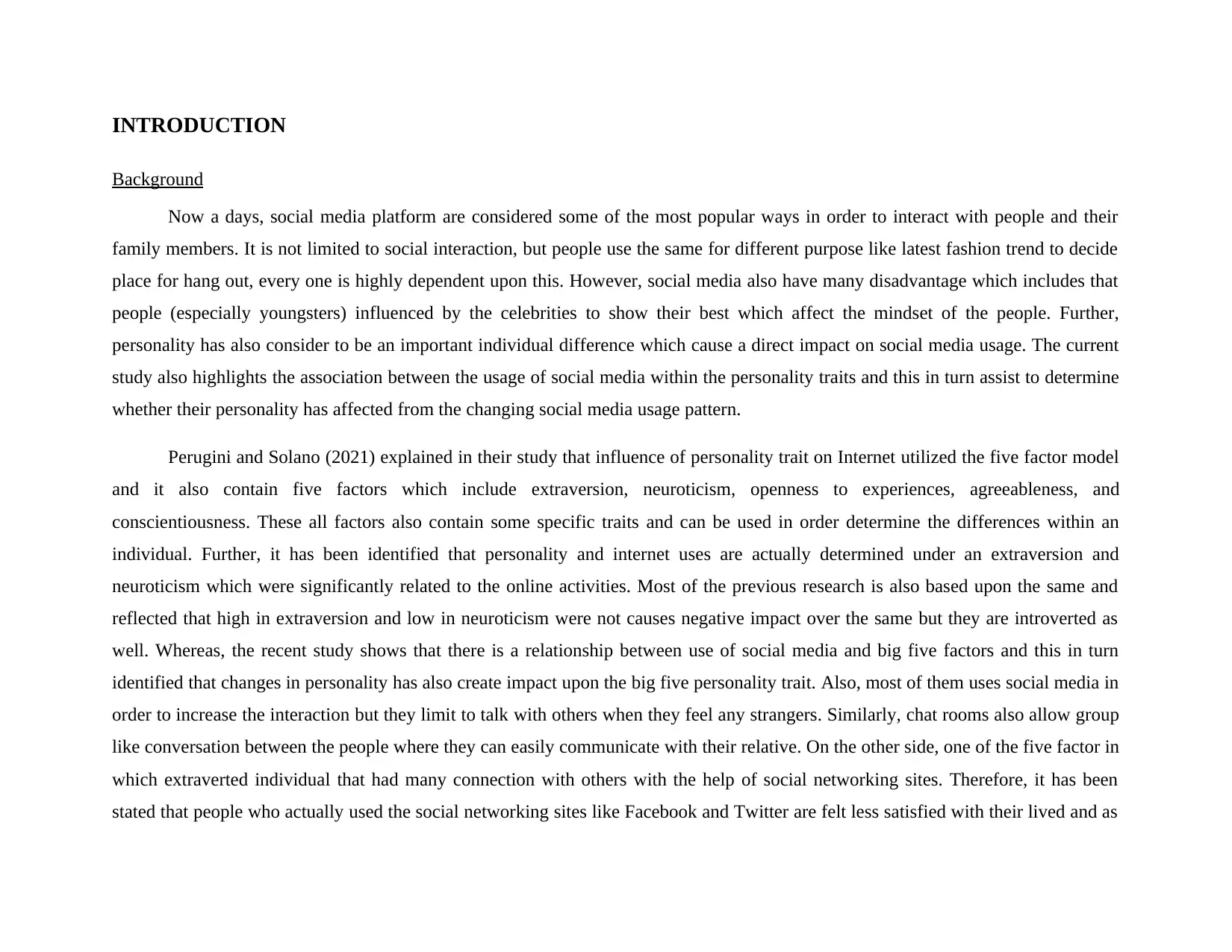
INTRODUCTION
Background
Now a days, social media platform are considered some of the most popular ways in order to interact with people and their
family members. It is not limited to social interaction, but people use the same for different purpose like latest fashion trend to decide
place for hang out, every one is highly dependent upon this. However, social media also have many disadvantage which includes that
people (especially youngsters) influenced by the celebrities to show their best which affect the mindset of the people. Further,
personality has also consider to be an important individual difference which cause a direct impact on social media usage. The current
study also highlights the association between the usage of social media within the personality traits and this in turn assist to determine
whether their personality has affected from the changing social media usage pattern.
Perugini and Solano (2021) explained in their study that influence of personality trait on Internet utilized the five factor model
and it also contain five factors which include extraversion, neuroticism, openness to experiences, agreeableness, and
conscientiousness. These all factors also contain some specific traits and can be used in order determine the differences within an
individual. Further, it has been identified that personality and internet uses are actually determined under an extraversion and
neuroticism which were significantly related to the online activities. Most of the previous research is also based upon the same and
reflected that high in extraversion and low in neuroticism were not causes negative impact over the same but they are introverted as
well. Whereas, the recent study shows that there is a relationship between use of social media and big five factors and this in turn
identified that changes in personality has also create impact upon the big five personality trait. Also, most of them uses social media in
order to increase the interaction but they limit to talk with others when they feel any strangers. Similarly, chat rooms also allow group
like conversation between the people where they can easily communicate with their relative. On the other side, one of the five factor in
which extraverted individual that had many connection with others with the help of social networking sites. Therefore, it has been
stated that people who actually used the social networking sites like Facebook and Twitter are felt less satisfied with their lived and as
Background
Now a days, social media platform are considered some of the most popular ways in order to interact with people and their
family members. It is not limited to social interaction, but people use the same for different purpose like latest fashion trend to decide
place for hang out, every one is highly dependent upon this. However, social media also have many disadvantage which includes that
people (especially youngsters) influenced by the celebrities to show their best which affect the mindset of the people. Further,
personality has also consider to be an important individual difference which cause a direct impact on social media usage. The current
study also highlights the association between the usage of social media within the personality traits and this in turn assist to determine
whether their personality has affected from the changing social media usage pattern.
Perugini and Solano (2021) explained in their study that influence of personality trait on Internet utilized the five factor model
and it also contain five factors which include extraversion, neuroticism, openness to experiences, agreeableness, and
conscientiousness. These all factors also contain some specific traits and can be used in order determine the differences within an
individual. Further, it has been identified that personality and internet uses are actually determined under an extraversion and
neuroticism which were significantly related to the online activities. Most of the previous research is also based upon the same and
reflected that high in extraversion and low in neuroticism were not causes negative impact over the same but they are introverted as
well. Whereas, the recent study shows that there is a relationship between use of social media and big five factors and this in turn
identified that changes in personality has also create impact upon the big five personality trait. Also, most of them uses social media in
order to increase the interaction but they limit to talk with others when they feel any strangers. Similarly, chat rooms also allow group
like conversation between the people where they can easily communicate with their relative. On the other side, one of the five factor in
which extraverted individual that had many connection with others with the help of social networking sites. Therefore, it has been
stated that people who actually used the social networking sites like Facebook and Twitter are felt less satisfied with their lived and as
Paraphrase This Document
Need a fresh take? Get an instant paraphrase of this document with our AI Paraphraser
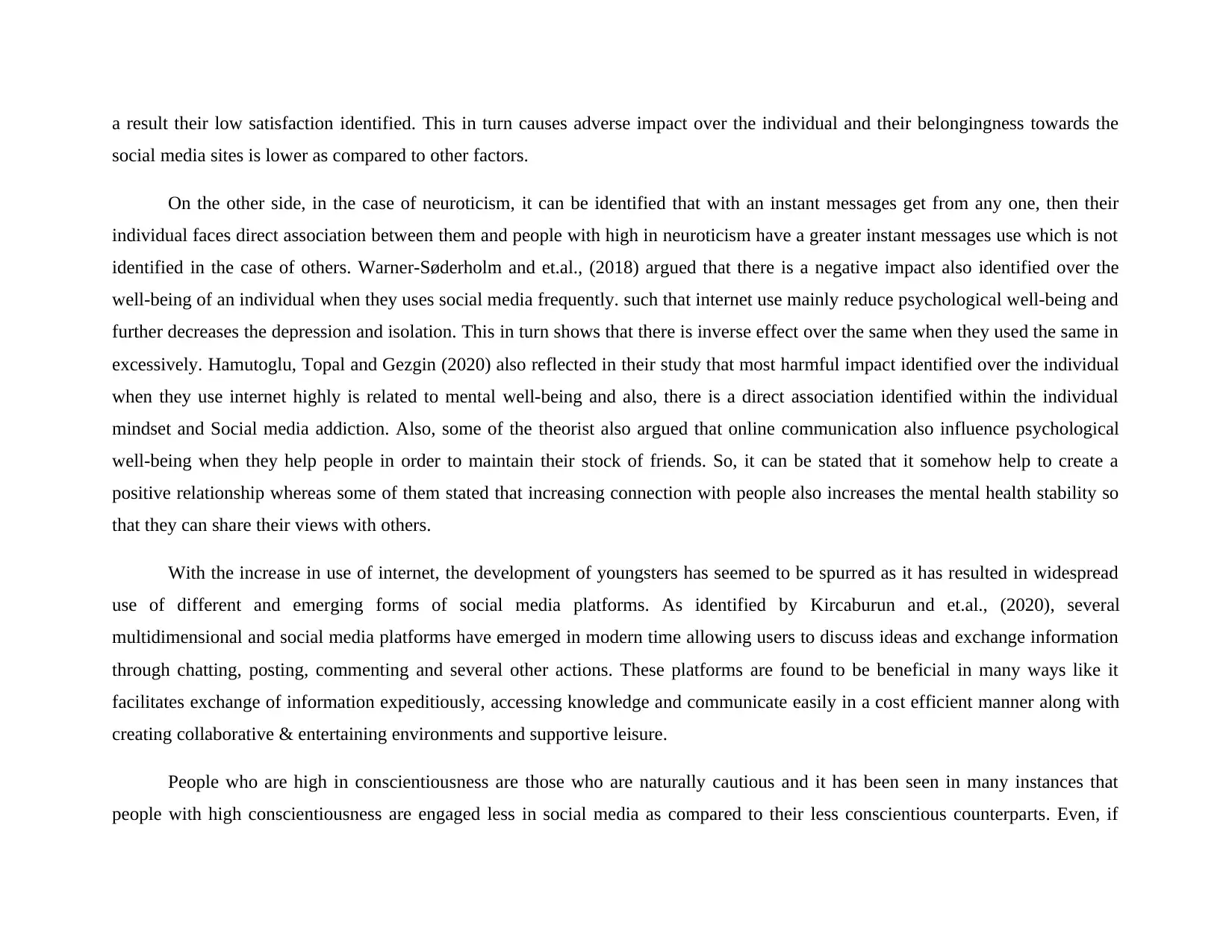
a result their low satisfaction identified. This in turn causes adverse impact over the individual and their belongingness towards the
social media sites is lower as compared to other factors.
On the other side, in the case of neuroticism, it can be identified that with an instant messages get from any one, then their
individual faces direct association between them and people with high in neuroticism have a greater instant messages use which is not
identified in the case of others. Warner-Søderholm and et.al., (2018) argued that there is a negative impact also identified over the
well-being of an individual when they uses social media frequently. such that internet use mainly reduce psychological well-being and
further decreases the depression and isolation. This in turn shows that there is inverse effect over the same when they used the same in
excessively. Hamutoglu, Topal and Gezgin (2020) also reflected in their study that most harmful impact identified over the individual
when they use internet highly is related to mental well-being and also, there is a direct association identified within the individual
mindset and Social media addiction. Also, some of the theorist also argued that online communication also influence psychological
well-being when they help people in order to maintain their stock of friends. So, it can be stated that it somehow help to create a
positive relationship whereas some of them stated that increasing connection with people also increases the mental health stability so
that they can share their views with others.
With the increase in use of internet, the development of youngsters has seemed to be spurred as it has resulted in widespread
use of different and emerging forms of social media platforms. As identified by Kircaburun and et.al., (2020), several
multidimensional and social media platforms have emerged in modern time allowing users to discuss ideas and exchange information
through chatting, posting, commenting and several other actions. These platforms are found to be beneficial in many ways like it
facilitates exchange of information expeditiously, accessing knowledge and communicate easily in a cost efficient manner along with
creating collaborative & entertaining environments and supportive leisure.
People who are high in conscientiousness are those who are naturally cautious and it has been seen in many instances that
people with high conscientiousness are engaged less in social media as compared to their less conscientious counterparts. Even, if
social media sites is lower as compared to other factors.
On the other side, in the case of neuroticism, it can be identified that with an instant messages get from any one, then their
individual faces direct association between them and people with high in neuroticism have a greater instant messages use which is not
identified in the case of others. Warner-Søderholm and et.al., (2018) argued that there is a negative impact also identified over the
well-being of an individual when they uses social media frequently. such that internet use mainly reduce psychological well-being and
further decreases the depression and isolation. This in turn shows that there is inverse effect over the same when they used the same in
excessively. Hamutoglu, Topal and Gezgin (2020) also reflected in their study that most harmful impact identified over the individual
when they use internet highly is related to mental well-being and also, there is a direct association identified within the individual
mindset and Social media addiction. Also, some of the theorist also argued that online communication also influence psychological
well-being when they help people in order to maintain their stock of friends. So, it can be stated that it somehow help to create a
positive relationship whereas some of them stated that increasing connection with people also increases the mental health stability so
that they can share their views with others.
With the increase in use of internet, the development of youngsters has seemed to be spurred as it has resulted in widespread
use of different and emerging forms of social media platforms. As identified by Kircaburun and et.al., (2020), several
multidimensional and social media platforms have emerged in modern time allowing users to discuss ideas and exchange information
through chatting, posting, commenting and several other actions. These platforms are found to be beneficial in many ways like it
facilitates exchange of information expeditiously, accessing knowledge and communicate easily in a cost efficient manner along with
creating collaborative & entertaining environments and supportive leisure.
People who are high in conscientiousness are those who are naturally cautious and it has been seen in many instances that
people with high conscientiousness are engaged less in social media as compared to their less conscientious counterparts. Even, if
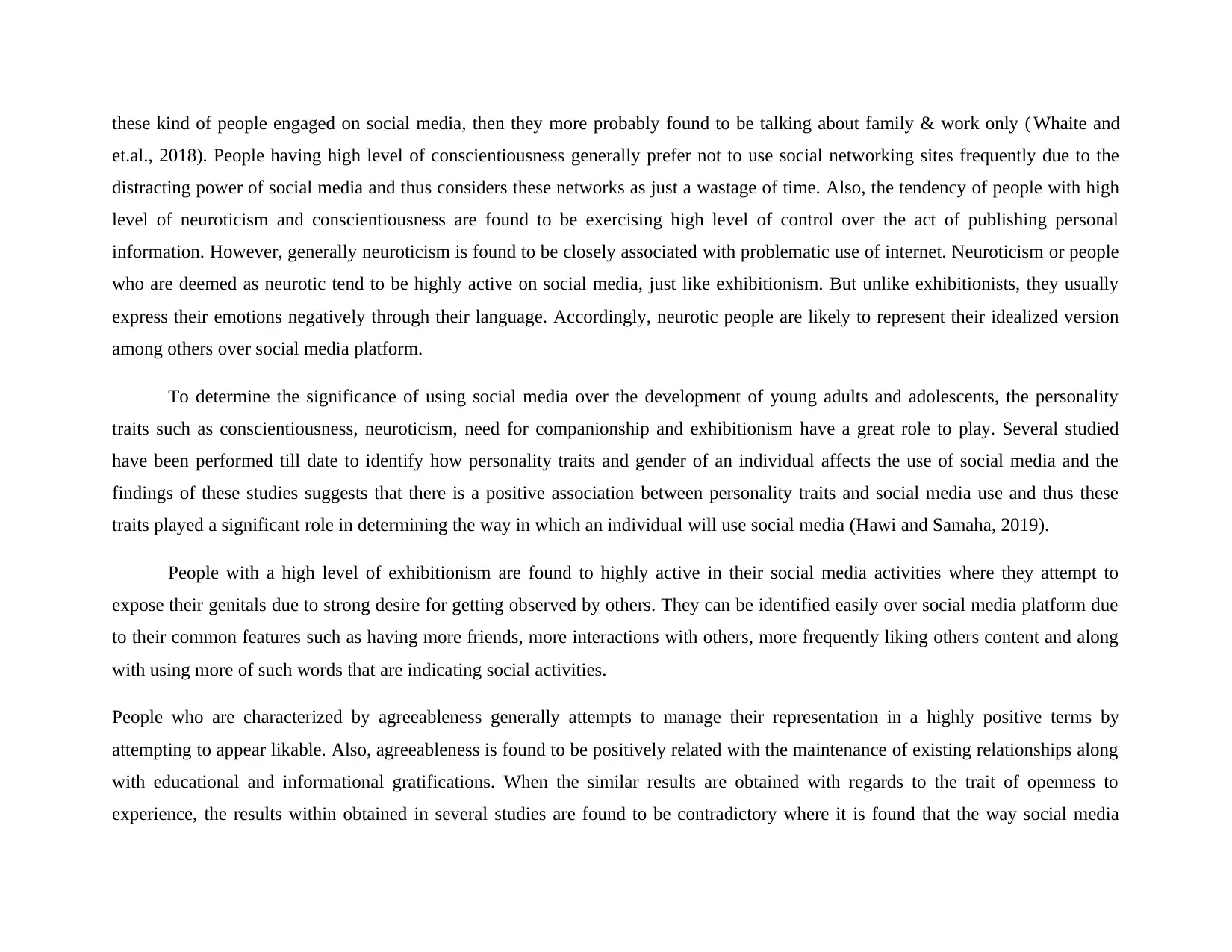
these kind of people engaged on social media, then they more probably found to be talking about family & work only ( Whaite and
et.al., 2018). People having high level of conscientiousness generally prefer not to use social networking sites frequently due to the
distracting power of social media and thus considers these networks as just a wastage of time. Also, the tendency of people with high
level of neuroticism and conscientiousness are found to be exercising high level of control over the act of publishing personal
information. However, generally neuroticism is found to be closely associated with problematic use of internet. Neuroticism or people
who are deemed as neurotic tend to be highly active on social media, just like exhibitionism. But unlike exhibitionists, they usually
express their emotions negatively through their language. Accordingly, neurotic people are likely to represent their idealized version
among others over social media platform.
To determine the significance of using social media over the development of young adults and adolescents, the personality
traits such as conscientiousness, neuroticism, need for companionship and exhibitionism have a great role to play. Several studied
have been performed till date to identify how personality traits and gender of an individual affects the use of social media and the
findings of these studies suggests that there is a positive association between personality traits and social media use and thus these
traits played a significant role in determining the way in which an individual will use social media (Hawi and Samaha, 2019).
People with a high level of exhibitionism are found to highly active in their social media activities where they attempt to
expose their genitals due to strong desire for getting observed by others. They can be identified easily over social media platform due
to their common features such as having more friends, more interactions with others, more frequently liking others content and along
with using more of such words that are indicating social activities.
People who are characterized by agreeableness generally attempts to manage their representation in a highly positive terms by
attempting to appear likable. Also, agreeableness is found to be positively related with the maintenance of existing relationships along
with educational and informational gratifications. When the similar results are obtained with regards to the trait of openness to
experience, the results within obtained in several studies are found to be contradictory where it is found that the way social media
et.al., 2018). People having high level of conscientiousness generally prefer not to use social networking sites frequently due to the
distracting power of social media and thus considers these networks as just a wastage of time. Also, the tendency of people with high
level of neuroticism and conscientiousness are found to be exercising high level of control over the act of publishing personal
information. However, generally neuroticism is found to be closely associated with problematic use of internet. Neuroticism or people
who are deemed as neurotic tend to be highly active on social media, just like exhibitionism. But unlike exhibitionists, they usually
express their emotions negatively through their language. Accordingly, neurotic people are likely to represent their idealized version
among others over social media platform.
To determine the significance of using social media over the development of young adults and adolescents, the personality
traits such as conscientiousness, neuroticism, need for companionship and exhibitionism have a great role to play. Several studied
have been performed till date to identify how personality traits and gender of an individual affects the use of social media and the
findings of these studies suggests that there is a positive association between personality traits and social media use and thus these
traits played a significant role in determining the way in which an individual will use social media (Hawi and Samaha, 2019).
People with a high level of exhibitionism are found to highly active in their social media activities where they attempt to
expose their genitals due to strong desire for getting observed by others. They can be identified easily over social media platform due
to their common features such as having more friends, more interactions with others, more frequently liking others content and along
with using more of such words that are indicating social activities.
People who are characterized by agreeableness generally attempts to manage their representation in a highly positive terms by
attempting to appear likable. Also, agreeableness is found to be positively related with the maintenance of existing relationships along
with educational and informational gratifications. When the similar results are obtained with regards to the trait of openness to
experience, the results within obtained in several studies are found to be contradictory where it is found that the way social media
⊘ This is a preview!⊘
Do you want full access?
Subscribe today to unlock all pages.

Trusted by 1+ million students worldwide
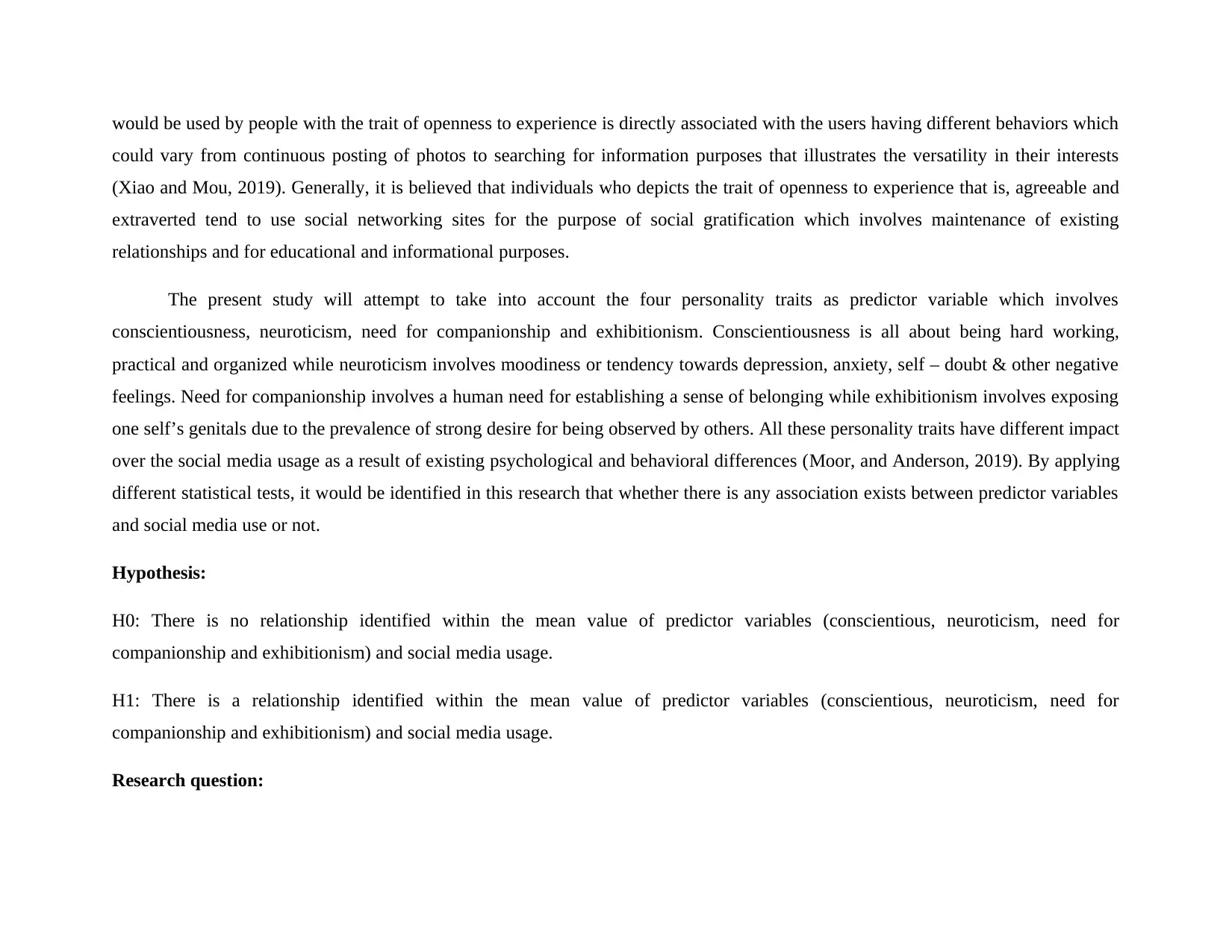
would be used by people with the trait of openness to experience is directly associated with the users having different behaviors which
could vary from continuous posting of photos to searching for information purposes that illustrates the versatility in their interests
(Xiao and Mou, 2019). Generally, it is believed that individuals who depicts the trait of openness to experience that is, agreeable and
extraverted tend to use social networking sites for the purpose of social gratification which involves maintenance of existing
relationships and for educational and informational purposes.
The present study will attempt to take into account the four personality traits as predictor variable which involves
conscientiousness, neuroticism, need for companionship and exhibitionism. Conscientiousness is all about being hard working,
practical and organized while neuroticism involves moodiness or tendency towards depression, anxiety, self – doubt & other negative
feelings. Need for companionship involves a human need for establishing a sense of belonging while exhibitionism involves exposing
one self’s genitals due to the prevalence of strong desire for being observed by others. All these personality traits have different impact
over the social media usage as a result of existing psychological and behavioral differences (Moor, and Anderson, 2019). By applying
different statistical tests, it would be identified in this research that whether there is any association exists between predictor variables
and social media use or not.
Hypothesis:
H0: There is no relationship identified within the mean value of predictor variables (conscientious, neuroticism, need for
companionship and exhibitionism) and social media usage.
H1: There is a relationship identified within the mean value of predictor variables (conscientious, neuroticism, need for
companionship and exhibitionism) and social media usage.
Research question:
could vary from continuous posting of photos to searching for information purposes that illustrates the versatility in their interests
(Xiao and Mou, 2019). Generally, it is believed that individuals who depicts the trait of openness to experience that is, agreeable and
extraverted tend to use social networking sites for the purpose of social gratification which involves maintenance of existing
relationships and for educational and informational purposes.
The present study will attempt to take into account the four personality traits as predictor variable which involves
conscientiousness, neuroticism, need for companionship and exhibitionism. Conscientiousness is all about being hard working,
practical and organized while neuroticism involves moodiness or tendency towards depression, anxiety, self – doubt & other negative
feelings. Need for companionship involves a human need for establishing a sense of belonging while exhibitionism involves exposing
one self’s genitals due to the prevalence of strong desire for being observed by others. All these personality traits have different impact
over the social media usage as a result of existing psychological and behavioral differences (Moor, and Anderson, 2019). By applying
different statistical tests, it would be identified in this research that whether there is any association exists between predictor variables
and social media use or not.
Hypothesis:
H0: There is no relationship identified within the mean value of predictor variables (conscientious, neuroticism, need for
companionship and exhibitionism) and social media usage.
H1: There is a relationship identified within the mean value of predictor variables (conscientious, neuroticism, need for
companionship and exhibitionism) and social media usage.
Research question:
Paraphrase This Document
Need a fresh take? Get an instant paraphrase of this document with our AI Paraphraser
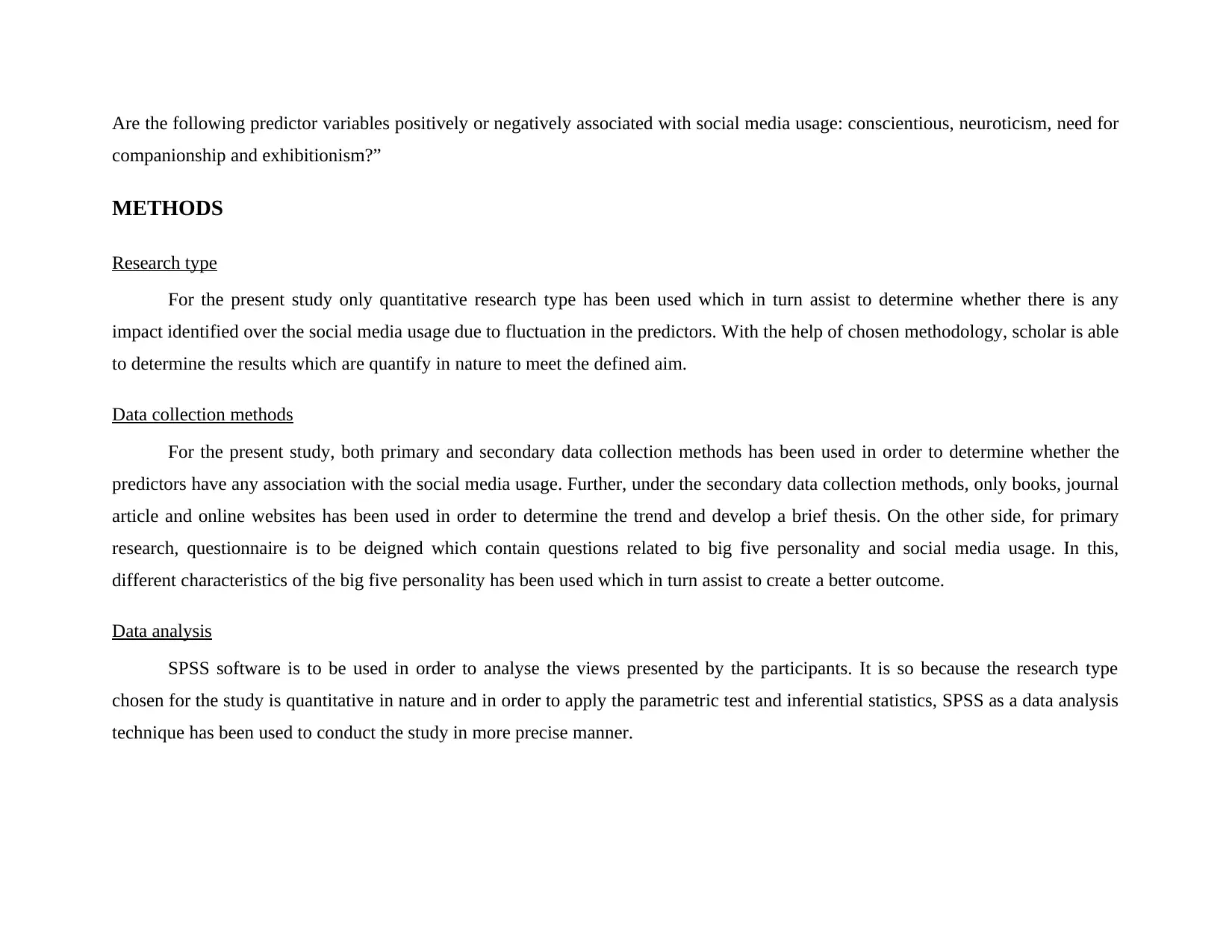
Are the following predictor variables positively or negatively associated with social media usage: conscientious, neuroticism, need for
companionship and exhibitionism?”
METHODS
Research type
For the present study only quantitative research type has been used which in turn assist to determine whether there is any
impact identified over the social media usage due to fluctuation in the predictors. With the help of chosen methodology, scholar is able
to determine the results which are quantify in nature to meet the defined aim.
Data collection methods
For the present study, both primary and secondary data collection methods has been used in order to determine whether the
predictors have any association with the social media usage. Further, under the secondary data collection methods, only books, journal
article and online websites has been used in order to determine the trend and develop a brief thesis. On the other side, for primary
research, questionnaire is to be deigned which contain questions related to big five personality and social media usage. In this,
different characteristics of the big five personality has been used which in turn assist to create a better outcome.
Data analysis
SPSS software is to be used in order to analyse the views presented by the participants. It is so because the research type
chosen for the study is quantitative in nature and in order to apply the parametric test and inferential statistics, SPSS as a data analysis
technique has been used to conduct the study in more precise manner.
companionship and exhibitionism?”
METHODS
Research type
For the present study only quantitative research type has been used which in turn assist to determine whether there is any
impact identified over the social media usage due to fluctuation in the predictors. With the help of chosen methodology, scholar is able
to determine the results which are quantify in nature to meet the defined aim.
Data collection methods
For the present study, both primary and secondary data collection methods has been used in order to determine whether the
predictors have any association with the social media usage. Further, under the secondary data collection methods, only books, journal
article and online websites has been used in order to determine the trend and develop a brief thesis. On the other side, for primary
research, questionnaire is to be deigned which contain questions related to big five personality and social media usage. In this,
different characteristics of the big five personality has been used which in turn assist to create a better outcome.
Data analysis
SPSS software is to be used in order to analyse the views presented by the participants. It is so because the research type
chosen for the study is quantitative in nature and in order to apply the parametric test and inferential statistics, SPSS as a data analysis
technique has been used to conduct the study in more precise manner.
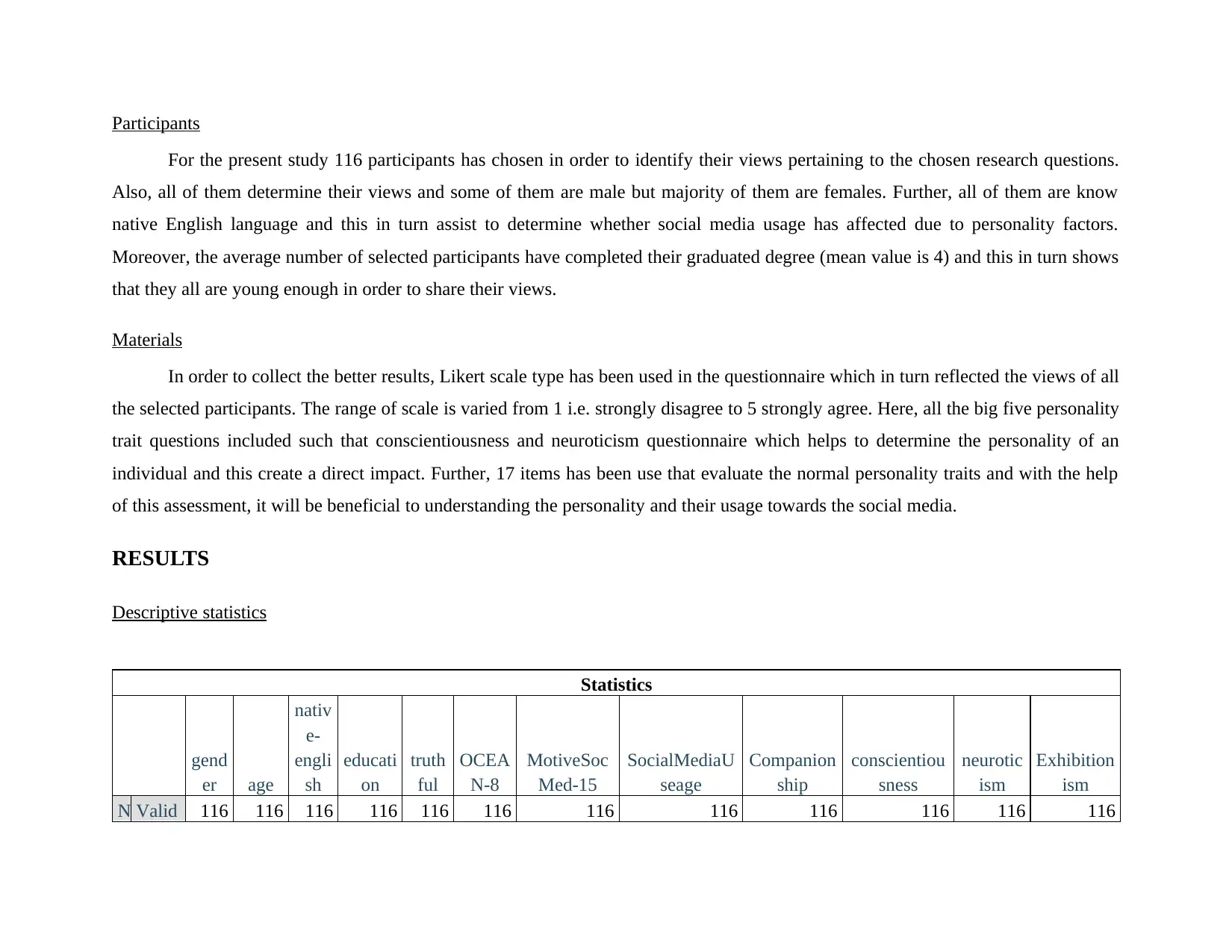
Participants
For the present study 116 participants has chosen in order to identify their views pertaining to the chosen research questions.
Also, all of them determine their views and some of them are male but majority of them are females. Further, all of them are know
native English language and this in turn assist to determine whether social media usage has affected due to personality factors.
Moreover, the average number of selected participants have completed their graduated degree (mean value is 4) and this in turn shows
that they all are young enough in order to share their views.
Materials
In order to collect the better results, Likert scale type has been used in the questionnaire which in turn reflected the views of all
the selected participants. The range of scale is varied from 1 i.e. strongly disagree to 5 strongly agree. Here, all the big five personality
trait questions included such that conscientiousness and neuroticism questionnaire which helps to determine the personality of an
individual and this create a direct impact. Further, 17 items has been use that evaluate the normal personality traits and with the help
of this assessment, it will be beneficial to understanding the personality and their usage towards the social media.
RESULTS
Descriptive statistics
Statistics
gend
er age
nativ
e-
engli
sh
educati
on
truth
ful
OCEA
N-8
MotiveSoc
Med-15
SocialMediaU
seage
Companion
ship
conscientiou
sness
neurotic
ism
Exhibition
ism
N Valid 116 116 116 116 116 116 116 116 116 116 116 116
For the present study 116 participants has chosen in order to identify their views pertaining to the chosen research questions.
Also, all of them determine their views and some of them are male but majority of them are females. Further, all of them are know
native English language and this in turn assist to determine whether social media usage has affected due to personality factors.
Moreover, the average number of selected participants have completed their graduated degree (mean value is 4) and this in turn shows
that they all are young enough in order to share their views.
Materials
In order to collect the better results, Likert scale type has been used in the questionnaire which in turn reflected the views of all
the selected participants. The range of scale is varied from 1 i.e. strongly disagree to 5 strongly agree. Here, all the big five personality
trait questions included such that conscientiousness and neuroticism questionnaire which helps to determine the personality of an
individual and this create a direct impact. Further, 17 items has been use that evaluate the normal personality traits and with the help
of this assessment, it will be beneficial to understanding the personality and their usage towards the social media.
RESULTS
Descriptive statistics
Statistics
gend
er age
nativ
e-
engli
sh
educati
on
truth
ful
OCEA
N-8
MotiveSoc
Med-15
SocialMediaU
seage
Companion
ship
conscientiou
sness
neurotic
ism
Exhibition
ism
N Valid 116 116 116 116 116 116 116 116 116 116 116 116
⊘ This is a preview!⊘
Do you want full access?
Subscribe today to unlock all pages.

Trusted by 1+ million students worldwide
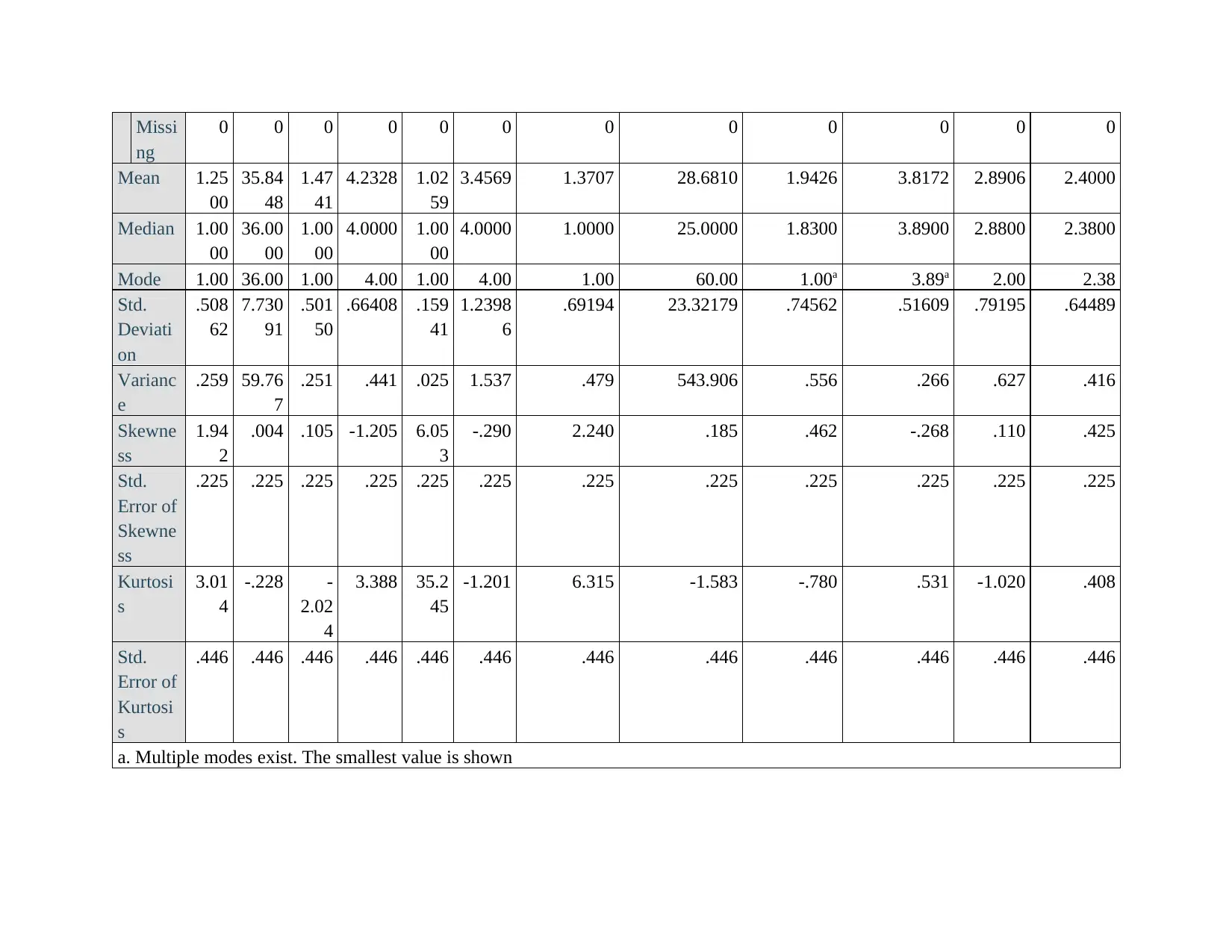
Missi
ng
0 0 0 0 0 0 0 0 0 0 0 0
Mean 1.25
00
35.84
48
1.47
41
4.2328 1.02
59
3.4569 1.3707 28.6810 1.9426 3.8172 2.8906 2.4000
Median 1.00
00
36.00
00
1.00
00
4.0000 1.00
00
4.0000 1.0000 25.0000 1.8300 3.8900 2.8800 2.3800
Mode 1.00 36.00 1.00 4.00 1.00 4.00 1.00 60.00 1.00a 3.89a 2.00 2.38
Std.
Deviati
on
.508
62
7.730
91
.501
50
.66408 .159
41
1.2398
6
.69194 23.32179 .74562 .51609 .79195 .64489
Varianc
e
.259 59.76
7
.251 .441 .025 1.537 .479 543.906 .556 .266 .627 .416
Skewne
ss
1.94
2
.004 .105 -1.205 6.05
3
-.290 2.240 .185 .462 -.268 .110 .425
Std.
Error of
Skewne
ss
.225 .225 .225 .225 .225 .225 .225 .225 .225 .225 .225 .225
Kurtosi
s
3.01
4
-.228 -
2.02
4
3.388 35.2
45
-1.201 6.315 -1.583 -.780 .531 -1.020 .408
Std.
Error of
Kurtosi
s
.446 .446 .446 .446 .446 .446 .446 .446 .446 .446 .446 .446
a. Multiple modes exist. The smallest value is shown
ng
0 0 0 0 0 0 0 0 0 0 0 0
Mean 1.25
00
35.84
48
1.47
41
4.2328 1.02
59
3.4569 1.3707 28.6810 1.9426 3.8172 2.8906 2.4000
Median 1.00
00
36.00
00
1.00
00
4.0000 1.00
00
4.0000 1.0000 25.0000 1.8300 3.8900 2.8800 2.3800
Mode 1.00 36.00 1.00 4.00 1.00 4.00 1.00 60.00 1.00a 3.89a 2.00 2.38
Std.
Deviati
on
.508
62
7.730
91
.501
50
.66408 .159
41
1.2398
6
.69194 23.32179 .74562 .51609 .79195 .64489
Varianc
e
.259 59.76
7
.251 .441 .025 1.537 .479 543.906 .556 .266 .627 .416
Skewne
ss
1.94
2
.004 .105 -1.205 6.05
3
-.290 2.240 .185 .462 -.268 .110 .425
Std.
Error of
Skewne
ss
.225 .225 .225 .225 .225 .225 .225 .225 .225 .225 .225 .225
Kurtosi
s
3.01
4
-.228 -
2.02
4
3.388 35.2
45
-1.201 6.315 -1.583 -.780 .531 -1.020 .408
Std.
Error of
Kurtosi
s
.446 .446 .446 .446 .446 .446 .446 .446 .446 .446 .446 .446
a. Multiple modes exist. The smallest value is shown
Paraphrase This Document
Need a fresh take? Get an instant paraphrase of this document with our AI Paraphraser
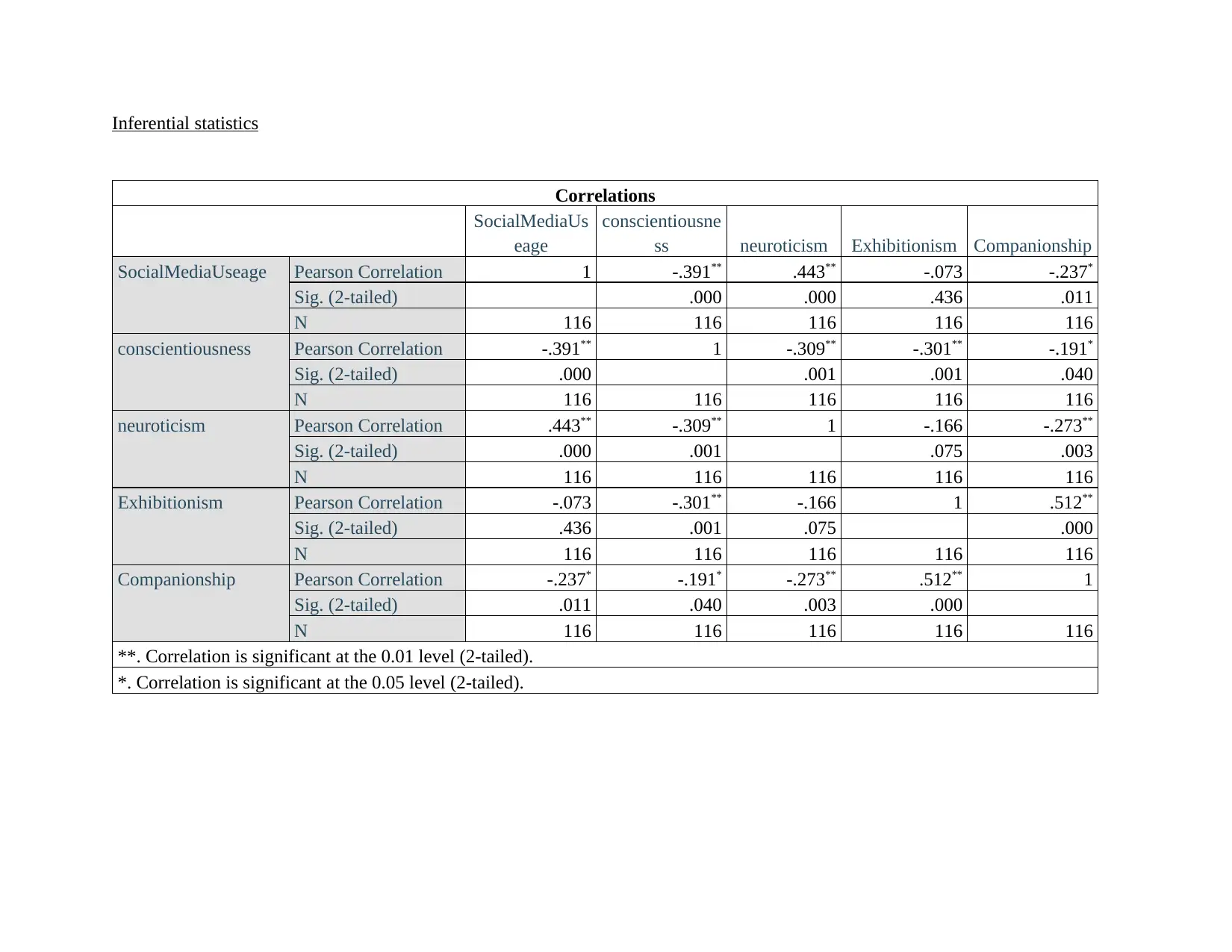
Inferential statistics
Correlations
SocialMediaUs
eage
conscientiousne
ss neuroticism Exhibitionism Companionship
SocialMediaUseage Pearson Correlation 1 -.391** .443** -.073 -.237*
Sig. (2-tailed) .000 .000 .436 .011
N 116 116 116 116 116
conscientiousness Pearson Correlation -.391** 1 -.309** -.301** -.191*
Sig. (2-tailed) .000 .001 .001 .040
N 116 116 116 116 116
neuroticism Pearson Correlation .443** -.309** 1 -.166 -.273**
Sig. (2-tailed) .000 .001 .075 .003
N 116 116 116 116 116
Exhibitionism Pearson Correlation -.073 -.301** -.166 1 .512**
Sig. (2-tailed) .436 .001 .075 .000
N 116 116 116 116 116
Companionship Pearson Correlation -.237* -.191* -.273** .512** 1
Sig. (2-tailed) .011 .040 .003 .000
N 116 116 116 116 116
**. Correlation is significant at the 0.01 level (2-tailed).
*. Correlation is significant at the 0.05 level (2-tailed).
Correlations
SocialMediaUs
eage
conscientiousne
ss neuroticism Exhibitionism Companionship
SocialMediaUseage Pearson Correlation 1 -.391** .443** -.073 -.237*
Sig. (2-tailed) .000 .000 .436 .011
N 116 116 116 116 116
conscientiousness Pearson Correlation -.391** 1 -.309** -.301** -.191*
Sig. (2-tailed) .000 .001 .001 .040
N 116 116 116 116 116
neuroticism Pearson Correlation .443** -.309** 1 -.166 -.273**
Sig. (2-tailed) .000 .001 .075 .003
N 116 116 116 116 116
Exhibitionism Pearson Correlation -.073 -.301** -.166 1 .512**
Sig. (2-tailed) .436 .001 .075 .000
N 116 116 116 116 116
Companionship Pearson Correlation -.237* -.191* -.273** .512** 1
Sig. (2-tailed) .011 .040 .003 .000
N 116 116 116 116 116
**. Correlation is significant at the 0.01 level (2-tailed).
*. Correlation is significant at the 0.05 level (2-tailed).
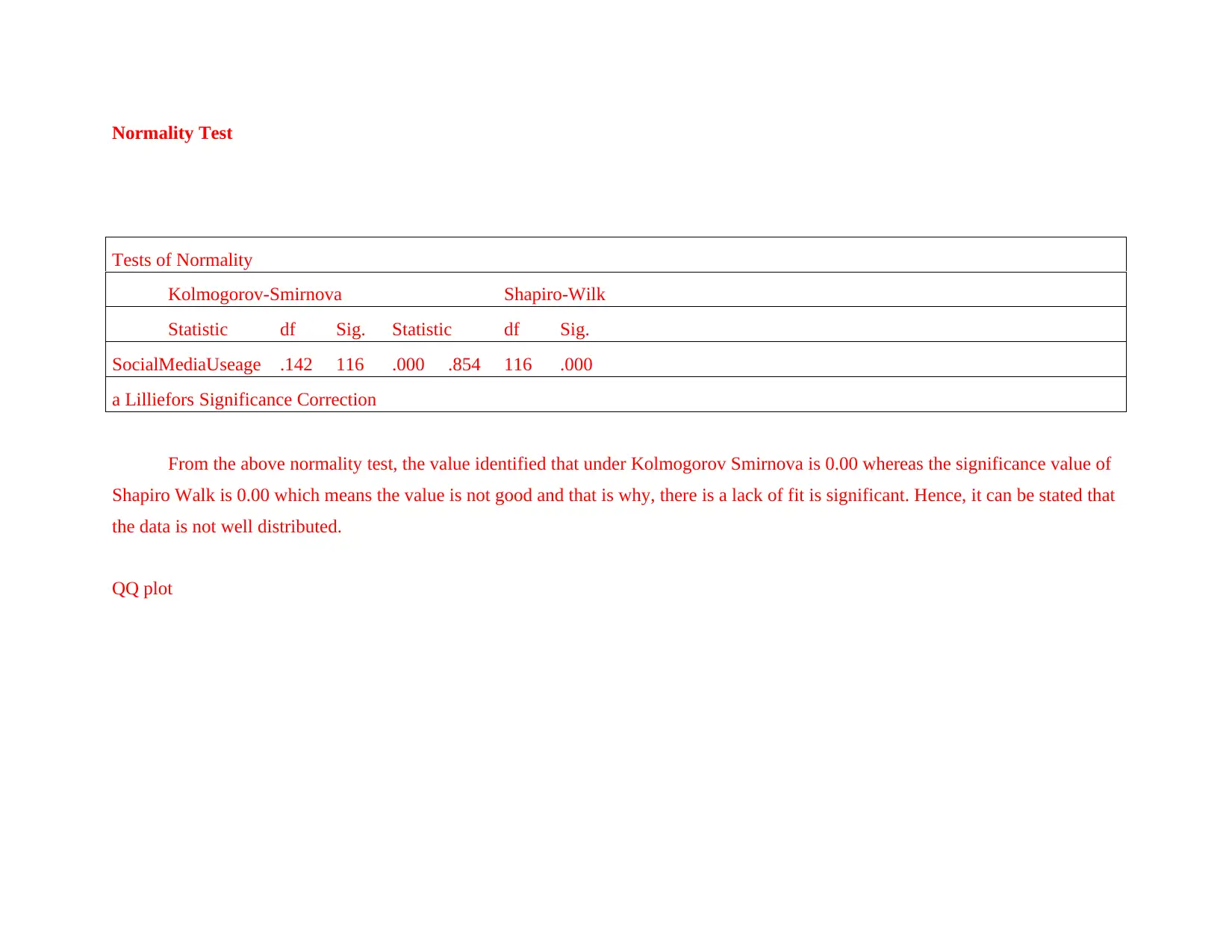
Normality Test
Tests of Normality
Kolmogorov-Smirnova Shapiro-Wilk
Statistic df Sig. Statistic df Sig.
SocialMediaUseage .142 116 .000 .854 116 .000
a Lilliefors Significance Correction
From the above normality test, the value identified that under Kolmogorov Smirnova is 0.00 whereas the significance value of
Shapiro Walk is 0.00 which means the value is not good and that is why, there is a lack of fit is significant. Hence, it can be stated that
the data is not well distributed.
QQ plot
Tests of Normality
Kolmogorov-Smirnova Shapiro-Wilk
Statistic df Sig. Statistic df Sig.
SocialMediaUseage .142 116 .000 .854 116 .000
a Lilliefors Significance Correction
From the above normality test, the value identified that under Kolmogorov Smirnova is 0.00 whereas the significance value of
Shapiro Walk is 0.00 which means the value is not good and that is why, there is a lack of fit is significant. Hence, it can be stated that
the data is not well distributed.
QQ plot
⊘ This is a preview!⊘
Do you want full access?
Subscribe today to unlock all pages.

Trusted by 1+ million students worldwide
1 out of 27
Related Documents
Your All-in-One AI-Powered Toolkit for Academic Success.
+13062052269
info@desklib.com
Available 24*7 on WhatsApp / Email
![[object Object]](/_next/static/media/star-bottom.7253800d.svg)
Unlock your academic potential
Copyright © 2020–2025 A2Z Services. All Rights Reserved. Developed and managed by ZUCOL.





